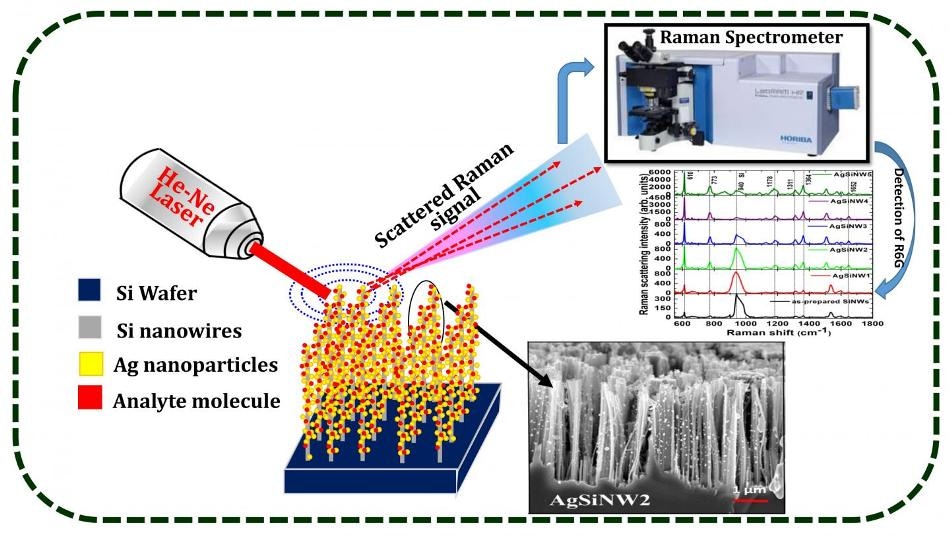Jan 4 2018
As pharmacology and medicine explore nanoscale processes, it has become progressively important to identify and characterize diverse molecules. Raman spectroscopy, a method that uses the scattering of laser light to identify molecules, has a narrow capacity to detect molecules in diluted samples due to low signal yield.
 Detection of a low concentration analyte molecules using silicon nanowires decorated with silver nanoparticles and surface enhanced Raman scattering measurements. (Photo credit: V.S. Vendamani)
Detection of a low concentration analyte molecules using silicon nanowires decorated with silver nanoparticles and surface enhanced Raman scattering measurements. (Photo credit: V.S. Vendamani)
A team of researchers from the University of Hyderabad in India have enhanced molecular detection at low concentration levels by positioning nanoparticles on nanowires in order to improve Raman spectroscopy. Surface-enhanced Raman spectroscopy (SERS) uses electromagnetic fields to enhance Raman scattering and improve sensitivity in standard dyes, such as R6G by over one billionfold.
The team decked up vertically aligned silicon nanowires with varied densities of silver nanoparticles, utilizing and improving the structure's 3D shape. Their results, published in the Journal of Applied Physics, from AIP Publishing, reveal that their device was able to optimize the Raman signals for cytosine protein and ammonium perchlorate by a factor of 100,000.
The beauty is that we can improve the density of these nanowires using simple chemistry. If you have a large density of nanowires, you can put more silver nanoparticles into the substrate and can increase the sensitivity of the substrate.
Soma Venugopal Rao, Author of 'Three-dimensional hybrid silicon nanostructures for surface enhanced Raman spectroscopy based molecular detection'
Applying the required nanostructures to SERS devices is still a challenge for the field. Constructing these structures in three dimensions with silicon nanowires has gained attention for their higher surface area and excellent performance; however silicon nanowires are still not economical to produce.
Instead, the researchers were able to identify a cheaper way to create silicon nanowires and used a method known as electroless etching to create a wide range of nanowires. They "decorated" these wires with silver nanoparticles with controlled and variable densities, which boosted the nanowires' surface area.
"Optimizing these vertically aligned structures took a lot of time in the beginning," said Nageswara Rao, one of the paper's authors. "We increased the surface area and to do this we needed to change the aspect ratio."
After improving their system to detect Rhodamine dye on a nanomolar level, these new substrates the team assembled improved Raman sensitivity by a factor of 10,000 to 100,000. The substrates identified concentrations of cytosine, a nucleotide found in DNA, and ammonium perchlorate, a molecule with a promise for detecting explosives, in as dilute concentrations as 50 and 10 micromolar respectively.
According to Nageswara Rao, the results have given the team motivation to believe that it might soon be possible to detect compounds in concentrations on the scale of nanomolar or even picomolar. The team's efforts have paved way for future research, from increasing the sharpness of the nanowires, experimenting with different nanoparticles such as gold, or testing these devices across several types of molecules.